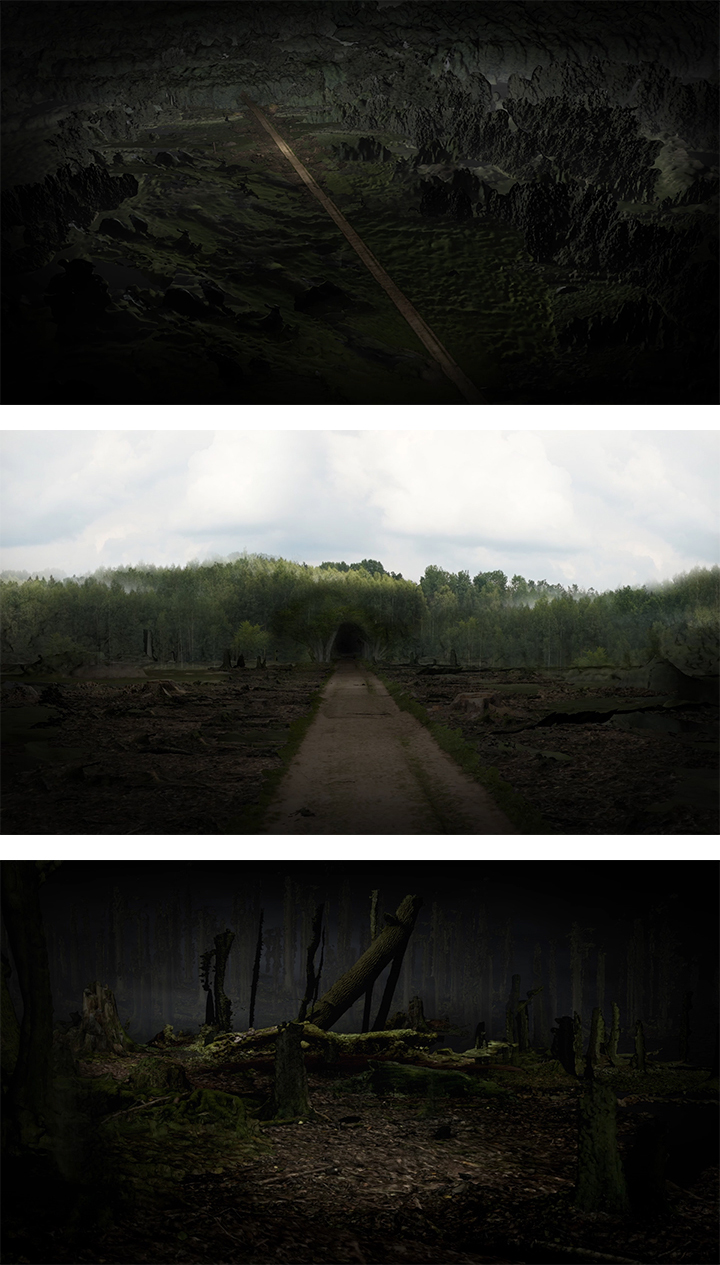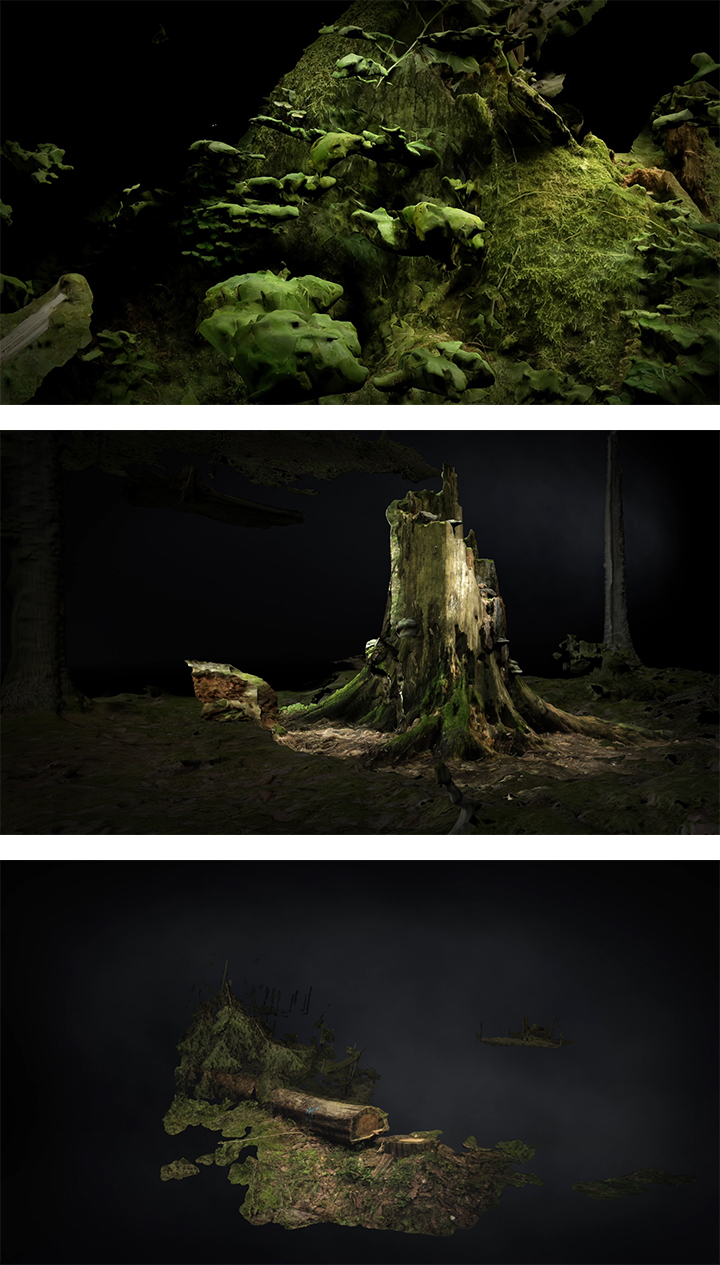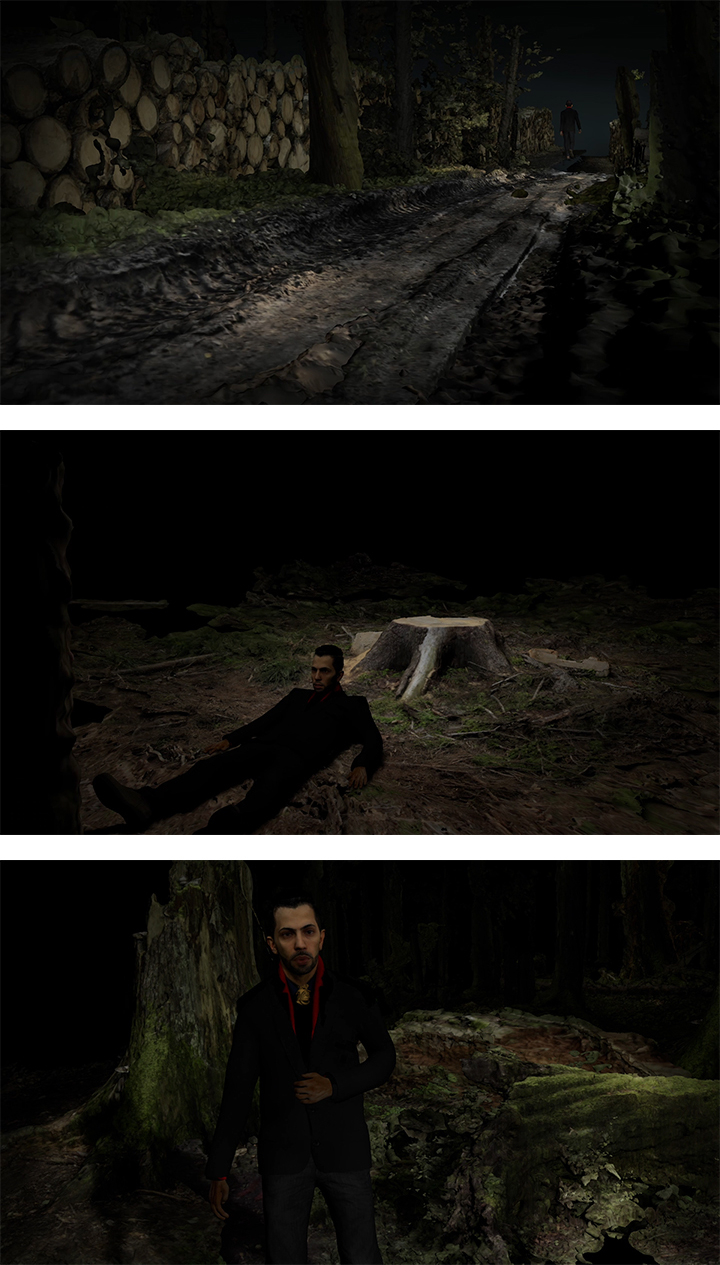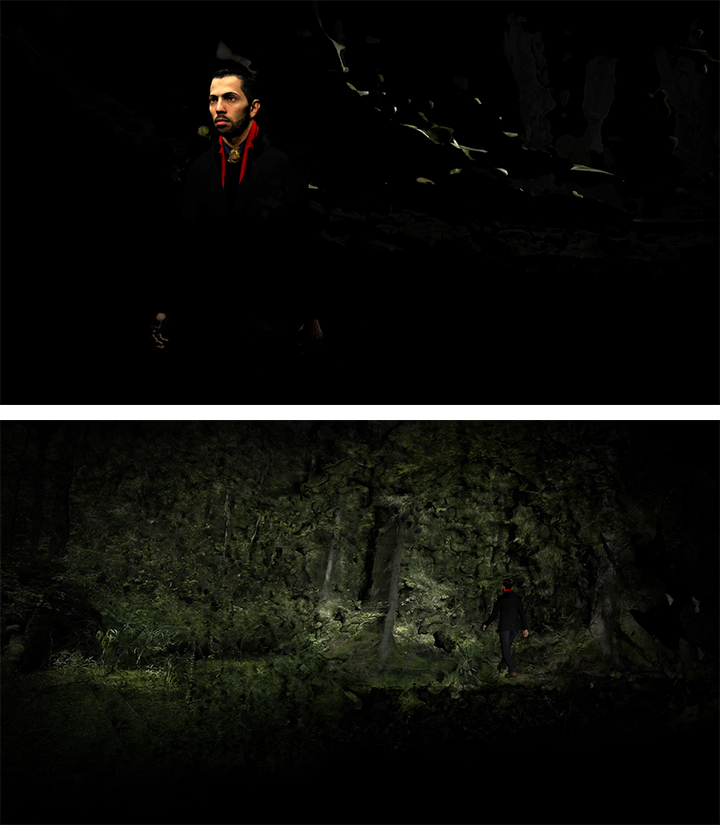Ausstellung »ZWISCHEN WURZEL UND WIPFEL –Fragmente aus dem Netzwerk Wald«
Exhibition »BETWEEN ROOT AND TREETOP – Fragments from the Forest Network«
–> Ausstellungs-Webseite / Exhibition website
Künstlerinformation / Artist information (translation below)
www.pmpmpm.com
HD-Film, 11:45 Min. mit Tonkomposition/with sound composition. Musik/Music: Berend Dubbe & Gwendolyn Thomas 11:45 min.
Courtesy by the artists und Akinci, Amsterdam.

Die Szene ist ein Meta-Bild, das den Betrachter dazu verleitet, einzutreten, mühelos mit der melancholischen Melodie zu schweben und ein sanftes, alptraumhaftes Bewusstsein zu erleben, dass alles in dieser Welt eine flüssige Bildfläche ohne festen Boden ist. Forest on Location basiert auf der digitalen Montage einer Vielzahl von fotografischen Bildern, die im Wald von Bialowieza aufgenommen wurden, zu 3D-Modellen von Baumstämmen und dem Waldboden. Ihre Oberfläche wird durch eine Reihe von Spuren unterbrochen, die dort absichtlich hinterlassen wurden, und die Bilder, die in manchen Momenten nur noch Umrisse darstellen, offenbaren ihr Medium als eine digitale Oberfläche, die unendlich formbar ist, ein Meta-Bild, das die Operationen seines eigenen Mediums aufzeigt.
Dennoch behält Forest of Location ein gewisses dokumentarisches Gewicht, das mit dem Anspruch des fotografischen Bildes zusammenhängt, der Realität seines Gegenstandes gerecht zu werden, seine materielle Präsenz zu erfassen und ihn in der Zeit einzufrieren. Abgesehen davon, dass sie im Zentrum der Begriffe "Beweis" oder "Dokument" steht, Begriffe, die eng mit unserem Verständnis und unserer Rekonstruktion der Vergangenheit verbunden sind, ist die Fotografie ein Medium mit einer außerordentlichen Plastizität und einer eigenen Geschichte, die sich heute sehr schnell verändert. Wir fotografieren immer mehr, die Bilder, die wir auf den Bildschirmen sehen, durchdringen unsere Erfahrung, unser Selbstbild und unsere Erinnerung und bestimmen sie sogar.
Die digitale Oberfläche von Fotografien ist kein Bild mehr, das man betrachtet oder anschaut. Sie ersetzt die harten Umrisse von Objekten und ist mit einer anderen Potenzialität ausgestattet; sie ist nicht länger ein Standbild, das einen Moment in der Vergangenheit registriert, sondern eine Oberfläche, die die Vergangenheit in eine formbare Gegenwart faltet, in der das Bild zu einer taktilen Oberfläche wird, die zum Zoomen und Scrollen, Bearbeiten, Überlagern und Teilen einlädt.
Die Künstler Persijn Broersen (Delft, 1974) und Margit Lukács (Amsterdam, 1973) bilden seit 2002 ein Duo. Sie besuchten beide die Gerrit Rietveld Academie, das Sandberg Instituut und die Rijksakademie van Beeldende Kunsten in Amsterdam.
Mit einer Fülle von Technologien, die unaufhörlich zitieren, referenzieren, einbetten und re-tweeten, hat sich die Art und Weise, wie Geschichten erzählt werden, tiefgreifend verändert. Ein Großteil der Arbeit von Broersen und Lukacs ist von diesen Fragen geprägt, die tief in ihrem Interesse an der Funktionsweise von Medien und Technologie verwurzelt sind und mit der Geschichte des Ornaments und der Politik der Darstellung von Landschaften aus politischen, mythologischen, (kunst)historischen und filmischen Quellen verwoben sind
Ihre Arbeiten, die aus überlagerten Projektionen, digitalen Animationen und Rauminstallationen bestehen, wurden von renommierten Institutionen und Organisationen weltweit ausgestellt, darunter die Biennale von Sydney (Australien), Rencontres Arles (FR), Wuzhen Biennial Now Is The Time (CN), Stedelijk Museum, Amsterdam (NL), FOAM (NL), MUHKA, Gent (BE), Centre Pompidou, Paris (FR), Shanghai World Expo (CN), Today's Art Museum (CN), Kröller Müller, Otterlo (NL), Haus der Kunsten der Welt Berlin (DE) / Louvre Paris (FR) für Rencontres Internationales Paris-Berlin und mehr.
Jüngste und kommende Ausstellungen sind unter anderem: The Botanical Revolution, Centraal Museum Utrecht (NL), And the Forests will Echo with Laughter, Eres-Stiftung, München (DE), The Real of Unreal (solo) A4ArtMuseum Chengdu (CN), Forest on Location (solo), A-Space, Toronto (CA), On Earth at Le Lieu Unique, Nantes (FR), Shaping the Invisible World. From Radical Cartography to Virtual Landscapes im HeK, Basel (CH) und Rubble: A Matter of Time in der Auckland Art Gallery (NZ), kuratiert von Juliana Engberg.

| »Forest on Location«, 2018. (Fimstills) HD-Film, 11:45 Min. mit Tonkomposition/with sound composition. Musik/Music: Berend Dubbe & Gwendolyn Thomas 11:45 min. Courtesy by the artists und Akinci, Amsterdam. |
The scene is a meta-image that entices the viewer to enter, to float effortlessly with the melancholic melody and experience a gentle, nightmarish awareness that everything in this world is a liquid canvas with no solid ground. Forest on Location is based on the digital montage of a variety of photographic images taken in the forest of Bialowieza into 3D models of tree trunks and the forest floor. Their surface is interrupted by a series of traces intentionally left there, and the images, which at some moments are only outlines, reveal their medium as a digital surface that is infinitely malleable, a meta-image that reveals the operations of its own medium.
Nevertheless, Forest of Location retains a certain documentary weight related to the photographic image's claim to do justice to the reality of its subject, to capture its material presence and to freeze it in time. Apart from being at the heart of the concepts of "evidence" or "document", concepts that are closely linked to our understanding and reconstruction of the past, photography is a medium with an extraordinary plasticity and a history of its own that is changing very rapidly today. We photograph more and more, the images we see on screens permeate and even define our experience, our self-image and our memory.
The digital surface of photographs is no longer an image that is viewed or looked at. It replaces the hard outlines of objects and is endowed with a different potentiality; it is no longer a still image that registers a moment in the past, but a surface that folds the past into a malleable present, in which the image becomes a tactile surface that invites you to zoom and scroll, edit, superimpose and share.
The artists Persijn Broersen (Delft, 1974) and Margit Lukács (Amsterdam, 1973) have formed a duo since 2002. They both attended Amsterdam’s Gerrit Rietveld Academie, the Sandberg Instituut and the Rijksakademie van Beeldende Kunsten.
With a plethora of technology that unceasingly quotes, references, embeds and re-tweets, the way stories are told has profoundly changed. Much of Broersen and Lukacs' practice is informed by these questions, deeply rooted in their interest in the workings of media and technology, intertwined with the history of ornament and the politics of depicting landscapes culled from political, mythological, (art)historical and filmic sources.
Their work, consisting of layered projections, digital animations and spatial installations, has been exhibited by renowned institutions and organisations worldwide, including the Biennale of Sydney (Australia), Rencontres Arles (FR), Wuzhen Biennial Now Is The Time (CN), Stedelijk Museum, Amsterdam (NL), FOAM (NL), MUHKA, Gent (BE), Centre Pompidou, Paris (FR), Shanghai World Expo (CN), Today’s Art Museum (CN), Kröller Müller, Otterlo (NL), Haus der Kunsten der Welt Berlin (DE) / Louvre Paris (FR) for Rencontres Internationales Paris-Berlin and more.
Recent and upcoming shows are among others: The Botanical Revolution, Centraal Museum Utrecht (NL), And the Forests will Echo with Laughter, Eres-Stiftung, Munchen (DE), The Real of Unreal (solo) A4ArtMuseum Chengdu (CN), Forest on Location (solo), A-Space, Toronto (CA), On Earth at Le Lieu Unique, Nantes (FR), Shaping the Invisible World. From Radical Cartography to Virtual Landscapes at HeK, Basel (CH) and Rubble: A Matter of Time at Auckland Art Gallery (NZ) curated by Juliana Engberg.



HD-Film, 11:45 Min. mit Tonkomposition/with sound composition. Musik/Music: Berend Dubbe & Gwendolyn Thomas 11:45 min.
Courtesy by the artists und Akinci, Amsterdam.
© Künstlerverein Walkmühle e.V.